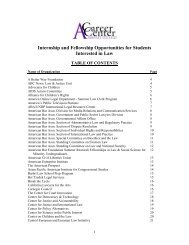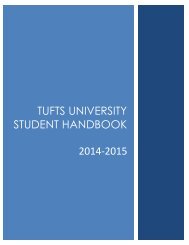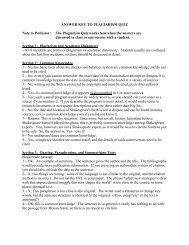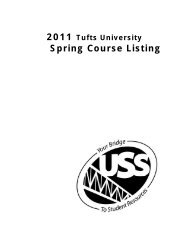2013â2014 The Bulletin - USS at Tufts - Tufts University
2013â2014 The Bulletin - USS at Tufts - Tufts University
2013â2014 The Bulletin - USS at Tufts - Tufts University
You also want an ePaper? Increase the reach of your titles
YUMPU automatically turns print PDFs into web optimized ePapers that Google loves.
College of Liberal Arts ><br />
humanities, the arts, the sciences, m<strong>at</strong>hem<strong>at</strong>ics, and<br />
the social sciences is a distinguishing characteristic<br />
of members of all the established professions.<br />
Faculty advisors are ready <strong>at</strong> all times to aid and<br />
counsel in making decisions.<br />
Seniors must file a degree sheet the semester<br />
prior to their expected d<strong>at</strong>e of gradu<strong>at</strong>ion. (Consult<br />
Undergradu<strong>at</strong>e Educ<strong>at</strong>ion in Dowling Hall.)<br />
Undergradu<strong>at</strong>e Minor Programs<br />
A student may have any number of majors and<br />
minors, provided there is only one disciplinary<br />
(departmental) minor. Two course credits used<br />
toward the departmental minor may be used toward<br />
a found<strong>at</strong>ion, distribution, or concentr<strong>at</strong>ion<br />
requirement. Two course credits used toward the<br />
interdisciplinary minor may be used toward a<br />
distribution or concentr<strong>at</strong>ion requirement, but not<br />
toward a found<strong>at</strong>ion requirement. All courses used<br />
in fulfillment of a minor must be taken for a grade<br />
(not pass/fail).<br />
Disciplinary (or Departmental)<br />
A minor is a coherent group of four to six course<br />
credits th<strong>at</strong> may be a limited version of a field of<br />
concentr<strong>at</strong>ion or a group of courses having closely<br />
rel<strong>at</strong>ed subject m<strong>at</strong>ter. Minors are optional and in<br />
no way replace the field of concentr<strong>at</strong>ion. <strong>The</strong><br />
object of a minor program is to present students<br />
with the basic concepts in a single scholarly<br />
discipline, including an introduction to appropri<strong>at</strong>e<br />
methodologies and ways of thinking about the<br />
subject.<br />
Students may have only one disciplinary<br />
(departmental) minor, regardless of the number of<br />
majors. Two course credits used toward the<br />
departmental minor may be used toward a found<strong>at</strong>ion,<br />
distribution, or concentr<strong>at</strong>ion requirement.<br />
Students may not complete both a minor and a<br />
concentr<strong>at</strong>ion (major) in the same discipline. Not<br />
all departments have minors, so students should<br />
consult department websites for additional inform<strong>at</strong>ion.<br />
Interdisciplinary<br />
An interdisciplinary minor involves a design<strong>at</strong>ed<br />
group of five credits from <strong>at</strong> least three departments<br />
or programs of the university, bringing to bear the<br />
knowledge and perspectives of various disciplines<br />
on a single subject. In addition to the five credits,<br />
students pursuing an interdisciplinary minor are<br />
required to complete a capstone project such as a<br />
research paper, an oral present<strong>at</strong>ion, or a performance,<br />
which integr<strong>at</strong>es the knowledge and<br />
methodologies of the disciplines involved.<br />
<strong>The</strong>re are a wide variety of interdisciplinary<br />
minors offered within Arts & Sciences (see list<br />
below). Students should consult the individual<br />
program website and/or program director prior to<br />
declaring a minor. Students may declare a minor<br />
only after they have declared a major concentr<strong>at</strong>ion.<br />
Students may have more than one interdisciplinary<br />
minor, regardless of the number of majors they<br />
have, and may have an interdisciplinary minor in<br />
addition to a departmental minor. Two credits used<br />
toward the interdisciplinary minor may be used<br />
toward a distribution or concentr<strong>at</strong>ion requirement,<br />
but not toward a found<strong>at</strong>ion requirement.<br />
While each interdisciplinary minor has its own<br />
requirements and processes, in general students are<br />
responsible for selecting an advisory committee of<br />
two appropri<strong>at</strong>e faculty members to support and<br />
evalu<strong>at</strong>e the work on the capstone project. Capstone<br />
projects are letter graded by the faculty<br />
advisory committee and can be taken for one-half<br />
or one course credit either within the individual<br />
program, or if the individual program does not have<br />
its own capstone course number, through CIS (CIS<br />
120: Interdisciplinary Minor Capstone). Individual<br />
interdisciplinary programs provide opportunities for<br />
students pursuing minors to share knowledge and<br />
resources in capstone courses, cohort meetings, and/<br />
or capstone present<strong>at</strong>ion events.<br />
<strong>The</strong> programs offering interdisciplinary minors<br />
approved by the Subcommittee on Academic<br />
Minors of the Committee on Curricula are listed<br />
below and should be consulted for their specific<br />
requirements and processes:<br />
Africa in the New World<br />
Africana Studies<br />
Asian American Studies<br />
Asian Studies<br />
Communic<strong>at</strong>ions and Media Studies<br />
Cognitive and Brain Sciences<br />
Film Studies<br />
Judaic Studies<br />
L<strong>at</strong>in American Studies<br />
L<strong>at</strong>ino Studies<br />
Leadership Studies<br />
17

















